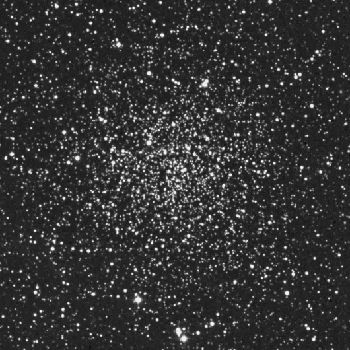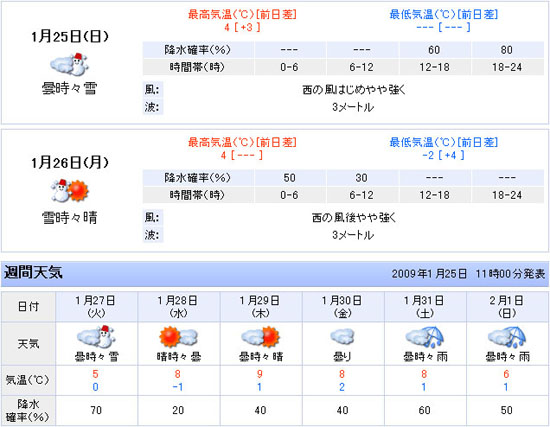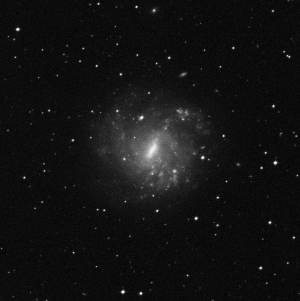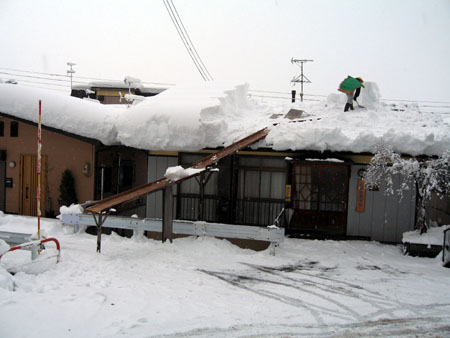
The snow block he removed was slipping down the wood trough that was set for this purpose.
2009
Monday,
December 21
It has been warm for December till last Wednesday, but suddenly temperature dropped and we had heavy snowfall. There was no snow on Thursday but the snow depth reached over 1 meter on Sunday. Now, the depth is kept over 1 meter.
Today, I saw a man snow removing in a traditional and tricky way.

The snow
block he removed was slipping down the wood trough that was set for this
purpose.
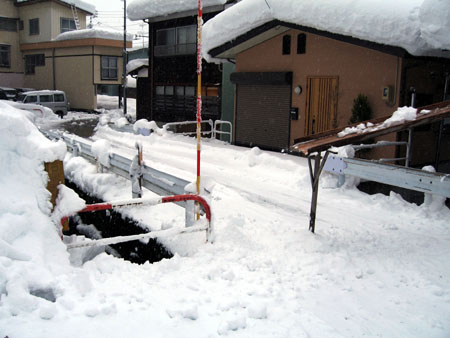
At the end of the
trough, snow block crossed the road and jumped into the flume.
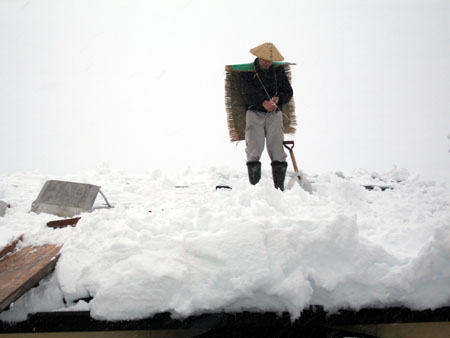
Having the
traditional hat and mantle he looked like a superman!
I have comet hunted once this month, and that may be the last one this year. I will go on a trip to Australia this year-end and new-year holiday, and will stay at Richard Brownfs house in NSW. He is a comet hunter and owns a 22h reflector.
I move from the snowy
place to the summer world, which may be hard but it is exciting to observe the
southern sky for the first time!
Sunday, December
13
I had been so busy for these three weeks that I could not afford to update my web page. Even worse, I worked too hard and am suffering from back ache, though it is getting better. I should take care because I am not young.
Last month I conducted
comet hunting seven times thanks to the good weather.
On Sunday November 22
when transparence was excellent, I mainly searched in the constellation of
Virgo, and identified 45 galaxies.
However, Tuesday November 24 was the most impressive session this year. My body sensors woke me up at 2:30a.m. well before the time when the alarm clock rang. I was drove to the observing site. The sky was superb with bright the winter Milky Way!
I searched Hydra and Crater where the effect of the zodiacal light is less and dark. The first galaxy that I detected was NGC2992 with the companion NGC2993, both are the 12th magnitude. At 4:07a.m. 47 minutes from the start of the session, a faint object came into the field of view. I tried to identify it using the NGC Sky Vector, but no suitable candidate appeared.
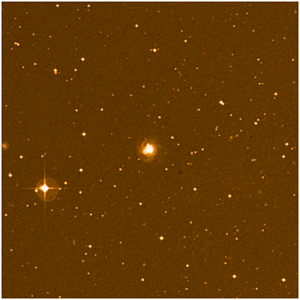
ESO 501-102
Image is 15' wide.
RA: 10h 50m 58.4s; Dec: -23
39' 30"; Mag: 13.3 (P); Size: 1.4'x1.1'
I acknowledge the usage of the
HyperLeda database (http://leda.univ-lyon1.fr).
I opened the Uranometria 2000.0 and I noticed a galaxy E501-12 is on the Atlas near the position of the suspicious object. I though that the object marked on the Atlas must be very dark since it belonged to European Southern Observatory Catalog and that it would not be observable using my comet-seeker. The object was a possible new comet!
I felt my heart beating. I changed the eyepiece from Planocular 30 mm 68x to
Ethos 13 mm 157x, but still the image was comet like. I carefully compared the
position with the Atlas and it turned out that the object was E501-12. I learned
that under the excellent sky condition I could observe very dark galaxy.
That was a disappointment, but I enjoyed a thrill. The galaxy was mistakenly
described as E501-12 in the Uranometria: the correct name is E501-102
(E=ESO).
Seven minutes later, a bright meteor crossed the FOV! It was third magnitude or brighter and the brightest I have ever seen through the telescope. At the next moment, a galaxy, NGC3621, and the meteor train appeared in the same FOV that lasted some 30 second! It was as if the heaven had celebrated my false discovery.
I encountered another faint galaxy that could not be identified by the NGC
Sky Vector. It turned out to be M3-28-27 (MCG-3-28-27) using the Uranometria. I
spent 2 hours and a quarter in totalsand it was a fruitful
session.
Sunday, November 15
At this predawn the sky condition was the best in this fall! The winter Milky Way arched brightly over the sky. However, the clear sky seemed to be a local phenomenon because I saw flash of lightning many times during the comet hunting session. Indeed, the meteorological radar image showed thunder storms with high rain fall intensity near my city.
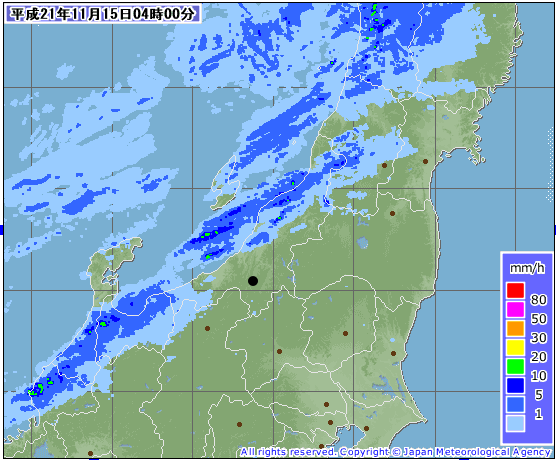
A solid circle indicates Tohkamachi where I live.
The map is
600km wide.
At 3:35a.m., before the start of the session I observed C/2007 Q3 Siding Spring. The comet was approaching to NGC4216, very elongated 11th magnitude galaxy, and I noticed both objects at first glance. I knew there were many galaxies in the field of view but could not recognize except for NGC4216 due to low altitude.
I started sweeping from Regulus, Alpha Leonid, and in 10 minutes M104 came into the field of view. The galaxy was only 5 degrees above the horizon, nonetheless, the dark lane in the nebula was easily visible!
At 4:40a.m. I watched C/2007 Q3 again, and this time I noticed six galaxies were in the same FOV! What if I had encountered the situation incidentally? Could I identify the comet? Probably, yes. I would check all the galaxies using the Uranometria 2000, though it would take some time. You have to be very careful for identification of doubtful objects.
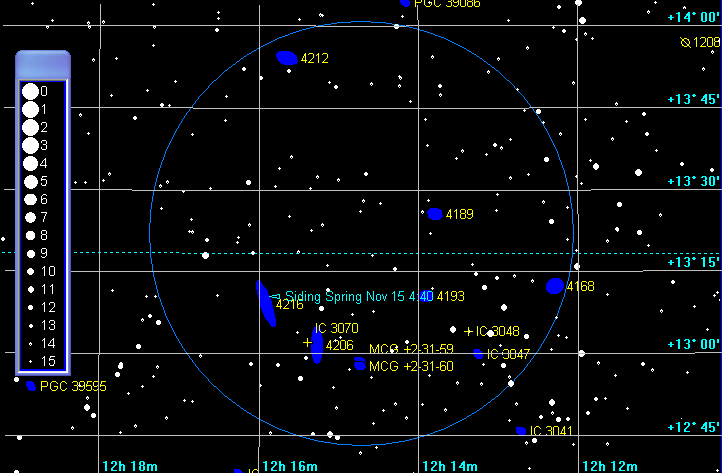
C/2007 Q3 Siding Spring with galaxies. The ciecle represents FOV:
1.3 degrees.
(c)MegaStar Ver.5.
I resumed the session. M65 and M66 were shining with pride and NGC3628 looked
like a huge elongated cloud. A minute later actual cloud covered more than half
of the sky before 5a.m. It was a negligible incident. I had quality
time.
Sunday, November 8
The alarm clock rang at 3 a.m. Though I went to bed at 8:50 p.m. last night, I felt sleepy and managed to get out of the bed at 3:10 a.m. The sky was clear with partial thin cloud.
During the session, the amount of cloud increased and I was compelled to change the search area four times.
1) I started comet hunting at 3:50 a.m. from M65 that looked fairly faint due to the moonlight and the low altitude. In 10 minutes thin cloud covered the region and I was forced to train my comet-seeker at the other direction.
2) I turned to the northeast, but a matter of minutes cloud hid the area.
3) The south was the
only cloudless direction, and I resumed from M41. Beautiful! Even under the
bright moonlight that reduced contrast in the field of view (FOV), I felt a
great joy with quite a few of stars in the winter Milky Way. Oddly, the
background in the FOV got darker and the contrast was enhanced as my
comet-seeker approached near the horizon: the angular distance between the moon
and the FOV increased with the downward motion of my telescope. It was
completely opposite what I have experienced during usual sessions. The moon was
as high as near the zenith that made the effect more prominent than usual moon
light night.
I wondered when it was and what I was doing, because the
twilight like situation continued long time because of the moonlight and
something was different with the hunting session. In other words the atmosphere
was unreal.
The moon was in thin cloud and had a halo, when I looked up her.
After around 30 minutes the area was covered with the cloud.
4) The comet-seeker was aimed at the southeast, but in 10 minutes cloud stretched this area.
5) Again, I observed M65 that looked much brighter than I saw at the beginning of the session at 3:50 a.m. I also noticed both NGC3628 that was not recognized at 3:50 a.m. and M66. I resumed the session from here and finished at 5:05 when thin cloud covered the entire sky. Then, I enjoyed moon watching through thin cloud using a binoviewer.
The motion of the
cloud was slow and the moonlight shed light on graceful shaped thin cloud
fantastically. The sky near the horizon offered darker background in the FOV due
to weaker moonlight than higher altitude. The lunar played an occult role for
this session and I enjoyed it.
Sunday, October
25
There appeared many fine days for a week and my body moved with the weather. I overdid comet hunting and a bit tired.
Nonetheless, I have never felt relaxed during the comet hunting sessions this month. Moonlight, light pollution (at dusk) and cloud interrupted me. Today, the eighth session this month, transparence was moderate at higher altitude, but poor at the lower part of the sky. Even so, I expected satisfactory hunting session this predawn.
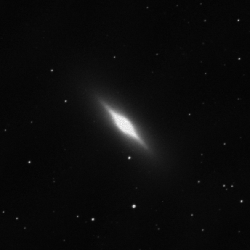
NGC3115,
Spindle galaxy
The image size is 10'.
The Digitized Sky
Survey copyright (c) 1994
I started with Alphard, Alpha Hydrae.
The first DSO that came into the field of view was NGC3115, Spindle galaxy.
Impressive! Soon after that, incredibly, cloud began to spread and it hid the
eastern sky. I was forced to search the other part of the sky, but every time I
aimed my comet-seeker at a certain part of the sky, cloud covered
there.
I searched from place to place patiently, and often looked up the sky. The Orionid was still active and I observed a few of them. Zodiacal light was bright that rose nearly vertical to the horizon.
The twilight proceeded
and M84 in Virgo disappeared from the field of view while I left my eye from the
eyepiece to take notes. The northern sky was still dark, and I continued
hunting. NGC4589, the 11th magnitude galaxy, was the last DSO I observed this
predawn at 4:55a.m., 20 minutes after the start of the twilight.
Tuesday October
13
Clear sky! Actually, I did not expect fine weather as the forecast has been off the mark many times, but I got up before 3 a.m. and it was rewarded. The waning moon was bright, but the transparence was good.
I started searching from the constellation of Leo, because many comets have been discovered there in October, as Tsutomu Seki pointed out. Nevertheless, I trained to my comet-seeker to the northeast after 30 minutes, since in Leo even the Messier Objects, which were at low altitude, could not be observable due to moonlight: the moon was in Cancer.
I came across many galaxies in Ursa Major and Canes Venatici: NGC3941, 3675, 4151, 4143, 4138, 4490, 4449 and M94. It was pleasure to observe 10 to 11th magnitude objects under the moonlight.
The session was completed at 4:55 a.m. when the hind legs of Leo and Venus rose above horizon.
Monday October 12 (National holiday)
Yesterday, as the forecast predicted clear sky throughout the night, I headed for the best observing site at 5 p.m. On the way to the site, raindrops hit the windshield of my car! Incredible!
I checked the weather information using my mobile phone, and it turned out that the prediction was modified from clear sky to cloudy and rainy. I decided to get back to my house.

The forecast released at 5 p.m. Oct. 11 said it would be cloudy
during the night (above), though in the morning the prediction stated the clear
sky would continue at night. Rainy trend is not displayed in the chart above but
the announcement in the text read there would be shower in some places.
As predicted it has been clear sky in daytime today, but again I was clouded
out at dusk: the forecast was off the mark. I comet hunted only once this
month, and the duration was merely 10 minutes due to
cloud.
Tuesday, September 29
I have comet hunted 7 times this month including the two nights spending in my car; I comet searched both at dusk and predawn. The most satisfactory one was conducted at predawn on Monday September 21. I could spot NGC2359 (the Duck Nebula) in Canis Major and also notice the planetary nebula in M46, NGC2438, at an altitude of as low as 15 degrees. The other impressive object was the Rosette Nebula that came across the field of my comet-seeker under the very dark background.
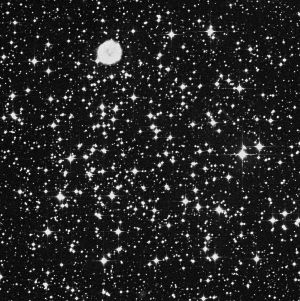
The planetary
nebula NGC2438 (upper left) in M46
The image is 15f wide.
The Digitized
Sky Survey copyright (c) 1994
Since then, the weather forecast was revised downward many times. I got up four predawns with the hope of clear sky, nevertheless, I could search the sky only once; at predawn on Thursday September 24 when the sky was very hazy.
Autumn is the best season for comet hunting here in my city, and I am anticipating to meeting with my love, the deep sky objects under the clear sky!
Wednesday
September 9
The twilight end: 7:30
p.m. The moonrise: 8:00 p.m.
I was thinking, gIt is possible to comet hunt
for about one hour, if I start at a quarter past sevenh. The problem was the
weather.
When I finished the work at 5:40 p.m., the sky began to clear, though it has been rainy and cloudy from the morning.
There still remained cloud near the mountainous area, but it seemed that the amount of cloud in the region also disappeared rapidly. I decided to go comet hunting at one of the best sites with an altitude of 800 m where it took one hour by car.
Lovely sunset! At the site, the sky was crystal clear. I finished setting up my comet-seeker at 7:20 p.m. The Milky Way arched over the sky with dark-lanes that reminded me that I am a member of our galaxy.
I wondered from where I started comet searching. The ecliptic was in the southwest where the light pollution of Nagano city messed up the sky. The south was full of summer showcases, but I dared to seek minor area: Bootes where there are no major DSOs and only dark galaxies can be observable.
Even at such a good observing site, at dusk all the sky less than 40 degrees in altitude looked very bright due to light pollution. The contrast in the field of view was not satisfactory, and I wondered no galaxy would be identified. It might be a monotonous session.
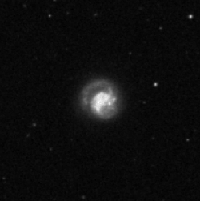

NGC5600 (left) and NGC5962 (right). The width of the image is
5f.
The Digitized Sky Survey copyright (c) 1994
However, I noticed a very faint object at the low altitude, some 20 degrees. I could not have recognized it, if it had not come into just the center of the field. The NGC Max identified the object as NGC5600, 12th magnitude galaxy. It was surprising that such a dark galaxy was spotted at the low altitude under the light polluted sky. The contrast looked low, but the limiting magnitude got darker with the help of the high altitude.
Another galaxy I met was NGC5962, 11th magnitude, in Serpens. It passed near the edge of the field, but it was easily recognized.
Both of the galaxies looked like small patches, but now, I knew that they
have unique appearance to see DSS image.
Wednesday August
26
An alarm clock woke me up at 1:50 am. The sky was clear!
Before the comet hunting session, I trained the comet-seeker at C/2006 W3 Christensen that was in the constellation of Sagitta, low in the western sky. Nevertheless, it looked bright with a short tail.
I wanted to begin with the adjoining region that I swept yesterday, i.e. western part of Orion. However, only the ESE of the sky was cloudy, and I started from near M1. I did not know Mars was in Taurus. The apparent diameter was easily recognizable with 67x, and I was sure that it was not a nova but Mars. M35 and NGC2158 were lovely, and the latter resolved into stars with 67x. I felt as if I had met an old friend, because the area has been hidden by the sunlight for some months and one could see the clusters.

M35 and NGC2158 (right
bottom)
The photo is 50 arc minutes wide.
The Digitized Sky Survey
copyright (c) 1994
I identified a planetary nebula NGC2392 (Eskimo nebula) in the twilight, which usually I miss, since the nebula is so bright that it is difficult to distinguish it from a star. This time, the twilight diminished the contrast of the nebula, and I could spot it. Instead, I overlooked a dark planetary nebula NGC2371 that I have often identified.
Changing the eyepiece
to Ethos 13 mm powered by a barlow lens, 313x, Eskimo was smiling in the
scintillation. How lucky and satisfactory to comet hunt two consecutive predawn
after long-lasting nasty weather!
Tuesday August
25
Autumn has come. It seems to be too early, but the atmosphere is getting cool with good transparency. Above all, the weather began to recover.
I got up at 2 am, but as the forecast said it was cloudy and I went to bed again. However, I anticipated the recovery of weather as I had noticed some small gasp in the cloud. At 2:20 am I got up again and it was getting better, and I decided to comet hunt.
When I completed setting up my comet-seeker at 2:55 am, the amount of cloud reduced to 50%. I aimed the telescope at the constellation of Eridanus where it was cloud less. I expected that I would encounter some dark galaxies in the region, and in 10 minutes I spotted the first one. It was an elongated object with 11th magnitude. Unexpectedly, the NGC Max could not identify the object, and at the next moment I remembered 217P LENEAR is in Eridanus. I compared the position with the comet list on the pad, and it actually turned out to be 217P.
In the end, the deep sky objects that came into the field during the session were only M79 and NGC1600 (galaxy). At 3:50 am cloud began to cover the sky rapidly, and the sky was overcast at 4 am.
Fortunately, I could
enjoy one hour hunting session.
Mon Aug 10
Unexpectedly, I could observe the impact spot on Jupiter tonight!
I have not set up my comet-seeker for about one and half month due to terrible weather. TV news said many people died and were missing in western Japan today because of food brought by Typhoon Etau or Typhoon No.9. I wonder if rain and cloudy weather continues till autumn, as El Nino that is the cause of bad wather is getting stronger.
At 10 p.m. when I was about to go to bed, I noticed moonlight was casted into the room floor from the window. Jupiter was shining! I have confirmed if the impact spot on Jupiter was visible using Internet, and it turned out that the transit time was around 11p.m.!
I hesitated to set up my 46 cm telescope and wondered smaller one would be better; while I was setting up the 46 cm Jupiter might be hidden by cloud. Fortunately, the gap of cloud was getting larger with time, and I decided to use the 46 cm.
It took 15 minutes to complete assembling and collimating my comet-seeker. Using Ethos 13 mm at 157x the impact spot was easy to recognize at a first glance! It was highly elongated and streak-like. While seeing was deteriorated the spot disappeared in the turbulence at any magnifications. Even so, with a little patience seeing recovered it appeared again.
If the impact occurs
on Earth, we human beings including other creatures face the extinction. Imagine
an asteroid or a comet is approaching to Earth and the impact may sweep all of
us: all we need is to save ourselves by all means. Donft you feel how stupid it
is to engage in warfare? It was what the impact told me.
Thu Jul 30
Rainy and
cloudy! No one could observe the totality in Jiaxing, China on July
22.
Till the day
before the totality, I heard it had been fine, and it was consistent with my
cloud observation over the area using the image of the meteorological
satellite.
Just after most
people had completed setting the telescopes, it began to rain. It ceased before
the totality, and we could enjoy darkness. Several minutes following the third
contact, we could observe Venus and partial eclipse through the gap of
cloud.
If the gap had opened earlier, we could have observed the totality for a while!
We were
disappointed the situation but enjoyed tourism in China.
I would like to
try the total eclipse again; however, the totality tour to the Easter Island in
2010 is too far and too expensive. I wonder if I could go over Australia in
2012.
@

Haneda Airport in Tokyo@
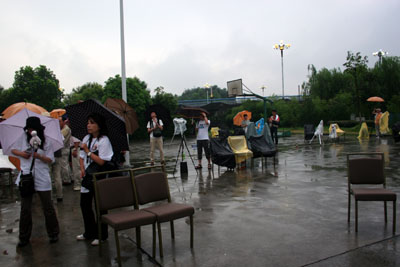
Before the totality it was
raining.@
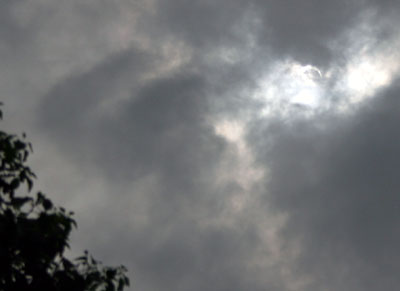
Some ten minutes following the
third contact.@

Yu Yuan (Garden in
Shanghai)
@
Shanghai Acrobatics

@
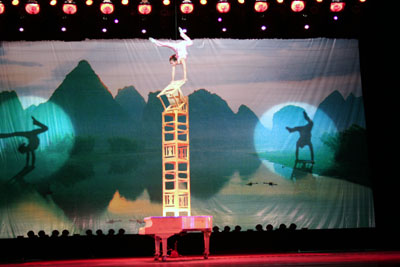
@
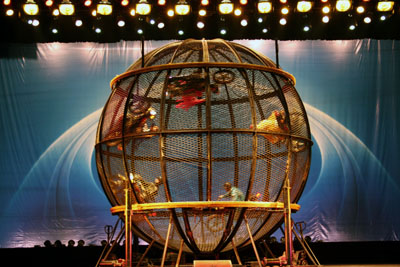
There were five motor-bikes in the
cage!@
Sun Jul 12
I have not conducted comet hunting since Sunday June 21 because
of my fatherfs death on June 25. He was 81 and had been in a nursing home for
one year due to dementia. My mother and one of my sisters were at his death bed,
but he had gone five and half hours before my arrival. It was natural death, and
we believe his was satisfied with his life. It seemed for me that the superb sky
on Sunday June 21 was the last smile from my father; he used to appreciate my
passion for the night sky in my boyhood.
It has been rainy and cloudy for more than a week now that it is rainy season, while the total eclipse is just around the corner. Rainy season has finished in Japanese southern islands of the totality zone, and I think it will be finished soon in Shanghai area, China where I visit the next week.
Clear sky and
great totality!
Sun Jun
21
Summer solstice!
It has been
cloudy, rainy, and foggy for nearly three weeks during the nights, even if it
was fine in daytime or forecasted fine. Contrary to the weather report, the sky
was crystal clear at noon.
As I will attend
the eclipse tour in China next month, I checked the solar filter and the optics
aiming them at the sun. Now, they are ready for the departure! The totality will
be the first experience for me. I do not want to take many photos, but to enjoy
visual observation.

Instrument for the totality tour in China. BORG125ED and Docter
Optic Nobilem 8x50B binocular.
Note that the
solar filter is installed in Quik Finder on BORG; it does not work under the
sunlight due to lack of LED brightness, though it was OK in the
room.
The clear sky
lasted till dusk, and I decided to go comet hunting to one of the best sites, in
spite of the pessimistic weather forecast that predicted it would be cloudy at
night. I arrived at the site during the twilight at 8:20p.m. and looked up the
sky; Arcturus looked much brighter than usual that meant excellent transparency!
Just when I completed setting up the comet-seeker, I was clouded out as
predicted!
I waited for
some 10 minutes, and luckily there appeared some gaps in the cloud in the west.
It was not wide enough to be able to comet hunt, and I trained the telescope at
Saturn. Superb! Seeing was excellent, and I changed the magnification as high as
500x using Ethos 8 mm and barlow. Even at 500x the image was rather clear and
the shadow of the ring casted on the body of Saturn was
outstanding.
The cloud gaps
near Saturn closed, but the amount of cloud reduced with time. C/2008 Q3 Garradd
was in the cloud but I aimed at the comet using the NGC Max, and I could observe
it! It had large apparent diameter, but disappeared in a minute. I noticed that
Scorpius was vim and vigor as if it had included many first magnitude stars. It
reminded me of the sky at Mauna Kea, Hawaii!
I finally began
to comet hunt at 9:15p.m. but was forced to sweep here and there, since cloud
moved into and hide the sweeping area many times.
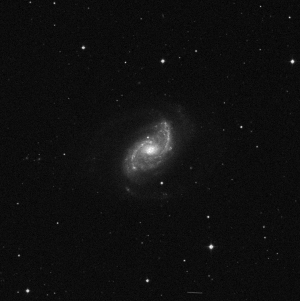
NGC5248
The image is15f wide.
The Digitized Sky Survey copyright (c)
1994
One of the
galaxies I spotted during the session, NGC5248 with 10th magnitude,
had apparent spiral structure at first glance at 68x! I finished the comet
hunting session at 10:20 because I wanted to enjoy watching DSOs. M8 and M20
looked pink and blue colored, and I recognized central star of M57 at 500x: it
was twinkling and was seen intermittently with averted vision for one quarter of
observing time. M22 and M5 were striking! M17 did not look like a shape of swan
but did strange: Omega?! I made a quick sketch.
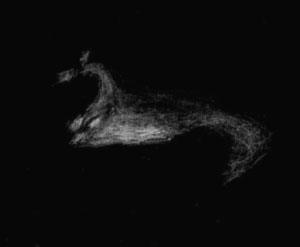
M17: 46 cm, Ethos 13 mm, 157x
Stars are not
drawn.
The limiting magnitude with naked eyes seemed to be 6.5 at most, but the combination of excellent transparency and seeing made the sky superb. I wanted to continue stargazing through the night, however, had to report to work the next morning. I took down the comet-seeker before midnight and got home at 1a.m. I was very excited with the wonderful sky, but exhausted and had a good sleep.
Tue June
2
I got up at 0:40a.m. and started the comet hunting session at 1:30a.m. in front of my house. I lost some 10 minutes before starting the session because of incredible mistake.
To set up the
digital setting circles, firstly, I trained my comet-seeker on Alpheratz, Alpha
Andromedae, which had just appeared above a forest stand. Secondly, I aimed it
at Polar Star, but the NGC Max showed an error message. I tried to again;
however, the result was the same. I checked if the setting of the encoder was
right and the cables were connected correctly. They were all
OK.
I did not know what happened. Anyway, this
time, I used a different pair of stars for activating the NGC Max, and finally
it worked correctly.
After half an hour, I
noticed that the star I believed to be Alpheratz was Algenib, Gamma
Andromedae (corrected on June 7,
2009) Pegasi! How careless! Alpheratz is lower right of Pegasusfs
quadrangle when Pegasus is in the west, while Algenib is lower right when
Pegasus rises from the east. This is one of reasons. In addition, you cannot
recognize the asterism of the constellations, when the constellations are low on
the horizon and some of the stars are hidden. These are the cause that I made a
mistake.
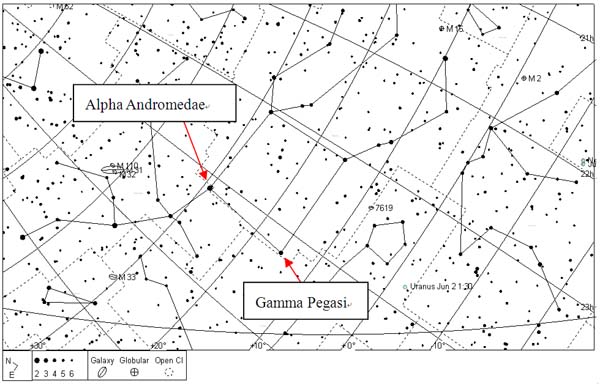
Alpheratz, Alpha Andromedae and Algenib, Gamma
Pegasi.This figure is added on June 7,
2009.
During the one
hour and forty five minutes session, I identified only one DSO, M2. There are
few DSO around the region, i.e. the east of Jupiter to
Pegasus.
To change the subject, it was pretty
cold this predawn. Air temperature was only 9 degrees Celsius with breeze. I
wore light down jacket and pants upon starting the session, but 20 minutes later
I changed them to heavy ones (cf. Comet
hunting wear). On the contrary, in daytime, air temperature rose as high as
30 degrees! You have to pay much attention to large temperature gap and lack of
sleep in this season.
Sat May
30
Regardless of optimistic forecast, it
had been cloudy during the nights this week. This predawn I got up at 0:40a.m.,
as I did a couple of times this week, and finally, I had a chance to conduct a
comet hunting session.
Transparency was
pretty good without cloud. I hoped that this situation continued until the
daybreak, but when I completed setting up my comet seeker, cloud began to
spread! The only cloudless area was Sagittarius, and I was forced to search the
area.
The first object I encountered was M24. There are
quite a few of star clusters and nebulae in this region, and I had a good time
with observing them. M22 was always striking, but the most impressive object I
identified during this session was a globular cluster, Palomar 8 (about 2.5
degrees east of M25: RA: 18h 41m 30s, Dec: -1949' 33"). Maybe, I
caught it for the first time. It was very faint with dark surface brightness,
11th magnitude and some 2f in diameter. When I observed this cluster
at 2a.m., thin cloud began to cover the area, and I was forced to turn my scope
from the south to the southeast.
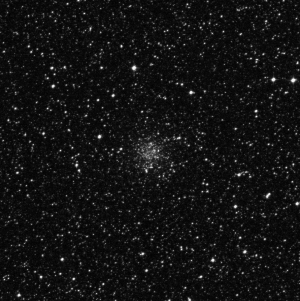
Palomar 8
The image is15f wide.
The Digitized
Sky Survey copyright (c) 1994
In the new sweeping
area there was 22P Kopff, but I could not spot the comet probably due to thin
cloud that began to cover the area, and the defused image of the comet; it was
reported that the comet had a magnitude of around 10 with DC (degree of
concentration) 2. At 2:35a.m. the cloud spread my sweeping area, and I must
change the search area again. I trained my comet seeker on the constellation of
Pegasus.
In the twilight I took a break to
observe C/2006 W3 Christensen. It was lovely and bright with a graceful wide
tail!
I finished the session at 3:05a.m., when
Venus rose above the SE horizon.
Wed May
13
I have had a
clod since Saturday (or maybe the flu but I do not know how to distinguish
them), and took sick leave on Monday and Tuesday. I consulted a general
practitioner, but could not get rid of it with ease. I reported to work today,
though I still have slight nasal inflammation with sore
throat.
When I finished todayfs work, the sky was
getting cloudless with superb transparency. I decided to go comet hunting. I
spent one hour drive from my home to the observing site where the altitude is
some 800 m above sea level. Before I started the comet hunting session, I tried
to observe two comets: C/2009 F6 Yi-SWAN and C/2008 T2
Cardinal.
I did not prepare the finding charts to
introduce these comets, and depended only on the digital setting circles
inputting the R.A. and R.D. with a magnification of 68x. At 8:20 p.m., 10
minutes before the end of the twilight, C/2008 T2 was identified easily. I felt
it was discoverable during a comet hunting session, and estimated the magnitude
was 11th with a diameter of 3f by intuition. While I could not
observe C/2009 F6, probably because light pollution and the low magnitude of the
comet.
I swept in the constellation of Gemini
mainly, and spent one hour and thirty five minutes. I caught a planetary nebula,
NGC2371. The irregular shape of the nebula was obvious at first glance. As
usual, I overlooked Eskimo nebula, NGC2392, since it is so bright with small
apparent diameter of 50h that you cannot tell the nebula from a
star.
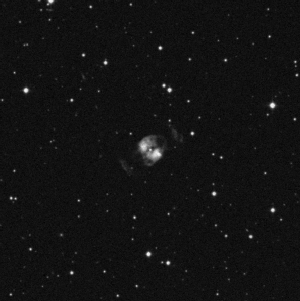
NGC2371
The image is10f
wide.
The Digitized Sky Survey copyright (c) 1994
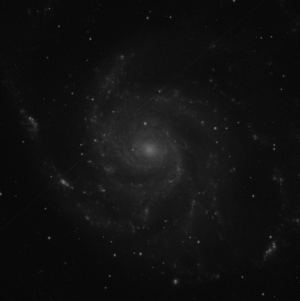
M101
The image is processed so that it is
similar to the visual image of 46 cm 157x. The image is15f wide.
The
Digitized Sky Survey copyright (c) 1994
The session
itself was comfortable, but light pollution was serious than at predawn
especially near the horizon. I completed sweeping before 10 a.m. and then,
enjoyed DSO using Ethos 13 mm with a magnification of 157 till the moonrise. The
spiral structure in M51 and M101, which was apparent with a direct vision, was
impressive that looked like photos. Five or more spiral arms were recognized in
M101with bright HII regions. A swarm of stars in globular clusters, M13, M3 and
M5, gave an impression of 3D.
I finished taking
dawn my comet-seeker at 11p.m. and got home before midnight. I had a good sleep
with attaining the peace of mind of satisfaction.
Thu Apr
30
It has been
clear for three consecutive days! I swept the predawn sky today and the day
before yesterday: yesterday, I went mountain-climbing with my friends from early
in the morning, and I gave up comet hunting with painful reluctance. I often go
one-day hike and skiing for fitness that is a basis of all of my activities
including comet searching. Taking a balance among many activities within limited
time is a critical issue at any time.
As the summer
solstice approaches, you have to get up earlier for the predawn comet hunting
session. I went out of the bed at 0:55a.m., and drove to one of the usual
observing sites. The sky was cloudless. Transparency was moderate at the high
altitude but bad at the lower part of the sky.
I
began to sweep from the east wing of Cygnus; the north-eastern sky seemed to be
less light-polluted in comparison with the other direction. Soon after the
beginning, I encountered a huge nebula, Veil Nebula. Only two comet-like
objects, galaxies NGC7217 and 7331, came across the field. The highlight of the
session was to have identified C/2006 W3 Christensen. Impressive! The comet was
bright with 9th magnitude by intuition, and had a short wide tail. I
cannot remember the time when I caught a known comet last during the comet
hunting session.
When I completed the session,
Jupiter was in the south-west, and Venus, as dazzling as Jupiter, rose above the
horizon.
Sat April 11
C/2009 G1 STEREO was
discovered from the image of the STEREO satellite. My search area on Monday,
April 6, covered the position of the discovery.
As I described
in my diary that updated on Wednesday, I identified M15 during the comet
hunting session at Monday predawn. The comet was located at almost the same
azimuth with M15; strictly speaking, the difference in the azimuth between the
two objects was 0.2 degrees at 4:15 a.m., the time when I supposed M15 came into
the field of view. I remembered that M15 passed through the field of my
comet-seeker twice, as I overlapped it enough. This means the
comet also must cross the field, since I swept the sky vertically as
usual.
I could not spot the comet as a result, because it was 20 minutes
after the beginning of the twilight when I reached the comet with the magnitude
of 10-11 and the altitude of 13 degrees above the horizon. Even worse,
transparency was moderate.
In my diary I wrote
that elong-term devotion and good luckf are necessary for discovery. This time I
could not due to the absence of good luck.
Mon Apr 6 – Tue Apr
7
I could comet hunt for two consecutive predawns. At
Monday predawn, transparency was moderate, but scintillation was steady and I
could concentrate on weeping the sky. The deep sky objects I identified were
NGC6934, a globular cluster in Delphinus, M2, NGC7006 also a globular cluster in
Delphinus, and M15. As the sky condition had been poor for one month, this comet
hunting session was satisfactory.
When I finished comet hunting session, the great
triangle in summer rose high in the sky and Jupiter was above the
horizon.
At Tuesday predawn, the time difference between the
moonset and the start of the twilight was only 10 minutes. The waxing moon was
bright, nevertheless, I began to search the heaven 20 minutes before the
moonset. The sky was much dustier than that of yesterday, which made light
pollution serious. I employed the light pollution filter, IDAS-LPS-P2, to
enhance contrast. Usually, I do not use the filter since it causes color
aberration and spoils the beauty of star field.
The limiting magnitude for comet-like objects seemed
to be 10th or brighter under such poor sky. I felt fulfilled for the
session with fine star ground in the summer Milky Way.
A new comet, C/2009 F6 Yi-SWAN, was discovered by
Dr. Dae-am Yi and SWAN. The position was out of my search area. I have yet
observed this comet, but Seki reported the magnitude was 11.5 using 15 cm
refractor. I believe both C/2009 E1 Itagaki and this comet could be discoverable
using 46 cm comet seeker under good sky condition.
Long-term devotion with good luck leads you to
discovery.
Tue Mar 24
I got up at 1
a.m., 2 a.m., and 3 a.m. this predawn. I did not know if the weather forecast
was off the mark or not (see the figure below), but cloud had covered the
predawn sky. Unfortunately, this happed many times this month.
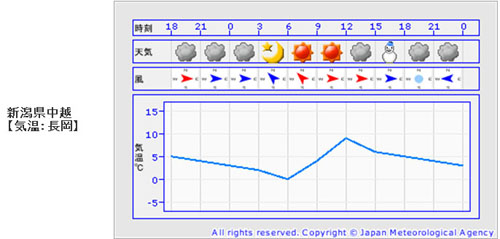
Weather forecast released at Monday
dusk.
At dusk, you can observe a new comet discovered
by the Japanese comet hunter Koichi Itagaki, C/2002 E1 Itagaki. I had a look at
it on Tuesday March 17, but at that time the sky was very dusty because of dense
yellow sand from Chinese desert. I could manage to identify the comet using my
46-cm comet seeker.
I knew Itagaki by name since my
boyhood, since he is an independent discoverer of C/1968 H1 Tago-Honda-Yamamoto.
Though his discovery was the first one in the world, he informed it using
express mail, and his name was not given to the comet. Recently, he discovered
dozens of supernovae, but in an astronomical magazine he said he actually wanted
to find a new comet. Last year, he spotted D/1896 R2 Giacobini with Hiroshi
Kaneda.
I congratulate him on the discovery!
I was
inspired by his grand achievement, and am eager to comet hunting under the clear
sky.
Greatness is the dream of youth realized in old
age.
-Alfred Victor Vigny
Fri Mar 6
Like yesterday I expected the clear sky, as the forecast predicted the
sky would be clear at predawn. I got up before 3 a.m., but this predawn I was
clouded out.
Thu
Mar 5
The
alarm-clock woke me up at 3 a.m. It was rather warm that implied cloudy, but
unexpectedly, the sky was clear with excellent transparency. I was happy to go
out to set up the comet-seeker.
I
was bewildered at the outside! The quarter was encompassed with dense fog. I did
not feel cold in the bed because it must be foggy or cloudy just before I got
up, and accidentally, it was fogless when I had a look at the sky from the
window.
I
had no choice. Instead of comet hunting near my house I drove 20 minutes to one
of the usual observing sites, however, it was cloudy there. I did not give up
the hunting session and decided to set up the telescope, as there were some
small gaps among the cloud. Just when I completed setting up the comet-seeker,
starry sky started enlarging in the north north-east.
As
I saw at my house transparency was pretty good, but filmy clouds crossed the
sweeping area from time to time. I expected to identify a few galaxies in this
region, Draco and Cepheus. Unexpectedlly, NGC6951 was the only galaxy I caught;
the galaxies would be hidden by the cloud. Nonetheless, delicate autumn Milky
Way in the region was impressive and I had premium
time.
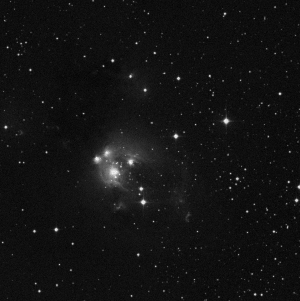
NGC7133. Reflection nebula in Cepheus.
The
image is 15f wide.
The Digitized Sky Survey copyright (c) 1994
At
the t beginning of the twilight a sparkling and exquisite open cluster came into
the field. I did not know what the cluster was. The NGC-Max told me it was
NGC7789 in Cassiopeia. The next object that made me excited was reflection
nebula. It looked like so at a glance since the object was superposed on some
bright stars. I checked it out using the digital setting circles that said the
object was NGC7133, a reflection nebula, as I thought.
I completed the session at 5:15 a.m. more than 30 minutes following the start of the twilight. The sky turned into cloudless before I knew it.
Tue 24
Feb
Last dusk there were two kinds of forecasts for the coming predawn, one
said it would be clear and another stated cloudy. I worried one more thing, fog.
Anyway, I went to bed early at 9p.m.
I
wake up at 3a.m. It was rather warm that often implied cloudy weather. I
approached the window, and it turned out that the outside was encompassed with a
dense fog. I gave comet hunting up, and went back to the
bed.
Sun 22 Feb
I
got up at 2:30a.m. Since the sky was crystal clear, C/2007 N3 Lulin was easily
recognized with naked eyes from the window! When I began to set up my comet
seeker, the comet could be seen with direct vision with an apparent diameter of
about 10f. In five minutes, suddenly, thin cloud spread all over the sky. I
waited for around one quarter, and the gap of the cloud enlarged. I started
comet hunting, however, transparency apparently reduced in comparison with
twenty minutes before.
I
began with the constellation of Scorpius as the gap opened only in the region.
An impressive double star, Beta Scorpii, which was dancing coincide with
scintillation, and many globular clusters, M80, M4, etc, came across the field
of view. Even through the thin cloud I enjoyed many summer
showpieces.
This predawn I looked forward to observing C/2007 N3, nonetheless, the
comet remained being hidden by the cloud. I patiently waited for its appearance
out of the cloud while I was sweeping the sky. Finally, the comet got out from
the cloud, and again I could see the comet with unaided eyes, but looked dimmer
and smaller because of thin cloud. With my comet seeker the dust tail of the
comet stretched as long as over one degree. The ion tail was difficult to
observe, and I could identify only a hint of it.
I resumed the hunting session, but transparency got worse with time. I finished the session 10 minutes following the beginning of the twilight when the thin moon with Earth light rose.
